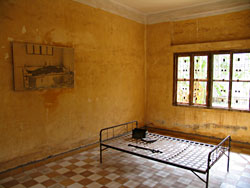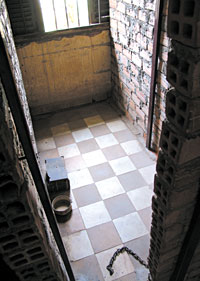 After 30 years, even genocide turns into a tourist attraction.
After 30 years, even genocide turns into a tourist attraction.
The Tuol Sleng prison in Phnom Penh has become just another stop on Cambodia's tourist itinerary. After walking past exhibits reminding them of the Khmer Rouge holocaust and brutality too horrible to imagine, visitors come out into the blinding sun to be greeted by a gift shop.
There are DVDs of the The Killing Fields, books on the Khmer Rouge period, Vishnu replicas from Angkor Wat and other tourist trinkets. You wonder what is more troubling: evil or its banality.
Tuol Sleng is like no other museum, it is a memorial to inhumanity, preserved to remind us of the cruelty that mankind is capable of. If such things could happen here, they can happen again anywhere. One in seven Cambodians died during the Khmer Rouge reign of terror between 1975-1979, and nearly 12,000 of them were systematically slaughtered here in Tuol Sleng. Among them, two thousand were children.
This used to be a three-storey school on a sleepy coconut-lined side street in Phnom Penh. The classrooms have cheerful, chequered yellow-and-white tiled floors and the playground had slides and swings. You can almost hear the sound of happy children shouting, running along the corridors. Today, there are only thousands of pictures of those executed and their ghosts roam the classrooms that were turned into torture chambers.  Exactly 30 years ago this month, the Khmer Rouge overran Phnom Penh, its victory hastened by the senseless carpet bombing of the Cambodian countryside by American B-52s in a desperate last-ditch effort to plug the Viet Cong's supply routes into South Vietnam. By the end of March 1975, the Americans had been defeated in Vietnam and the Khmer Rouge was poised at the gates of Phnom Penh. The US-backed regime of Gen Lon Nol collapsed and the rebels overran the city soon after. Prince Norodom Sihanouk returned from exile in China - and Cambodia became the world's first and only Maoist monarchy.
Exactly 30 years ago this month, the Khmer Rouge overran Phnom Penh, its victory hastened by the senseless carpet bombing of the Cambodian countryside by American B-52s in a desperate last-ditch effort to plug the Viet Cong's supply routes into South Vietnam. By the end of March 1975, the Americans had been defeated in Vietnam and the Khmer Rouge was poised at the gates of Phnom Penh. The US-backed regime of Gen Lon Nol collapsed and the rebels overran the city soon after. Prince Norodom Sihanouk returned from exile in China - and Cambodia became the world's first and only Maoist monarchy.
In the 1930s, Khmer Rouge leaders Pol Pot, Khieu Samphan, Ieng Sary and Son Sen had graduated from Cambodia's elite schools and were hand-picked to go to France for higher studies. In Paris, they were influenced by Vietnamese communists and soon came to believe in the inevitability of an armed struggle. But, being extreme nationalists, they fell out with the Vietnamese, and went on to propound a "clean revolution.an improvement on Lenin and 10 years ahead of Mao". Pol Pot boasted that his revolution was "not just a class struggle but a revolution against history itself".  By mid-1975 it was becoming chillingly clear what he meant. Cities were evacuated, money was abolished, everyone ate in group kitchens, communes were set up, religion was banned, children separated from parents, everyone dug irrigation trenches or planted paddy 14 hours a day. As food got scarce, the elderly and infirm were led off at night to be executed usually by blows to the head. Intellectuals, academics, traders, writers, artists were singled out to be killed. Estimates vary, but by the time Vietnamese forces liberated Phnom Penh in 1979, between 1-1.5 million Cambodians out of a population of 7 million had been killed or had died of hunger or disease. Among the dead were five out of Prince Sihanouk's 12 children.
By mid-1975 it was becoming chillingly clear what he meant. Cities were evacuated, money was abolished, everyone ate in group kitchens, communes were set up, religion was banned, children separated from parents, everyone dug irrigation trenches or planted paddy 14 hours a day. As food got scarce, the elderly and infirm were led off at night to be executed usually by blows to the head. Intellectuals, academics, traders, writers, artists were singled out to be killed. Estimates vary, but by the time Vietnamese forces liberated Phnom Penh in 1979, between 1-1.5 million Cambodians out of a population of 7 million had been killed or had died of hunger or disease. Among the dead were five out of Prince Sihanouk's 12 children.
Although the Khmer Rouge had sealed off the country from the outside world, word immediately started filtering out of the atrocities. The United States, still smarting from its defeat in Vietnam, considered the enemy of its enemy a friend. China and Thailand looked away, too. And even though millions were forcibly displaced and hundreds of thousands were being killed, the international community rewarded 'Democratic Kampuchea' with a seat at the United Nations. The year that Mao Zedong died in Beijing, his incarnates in Cambodia began to improve on Mao's vision of a peasant utopia.  The Khmer Rouge was paranoid about infiltration. When the purges began, they were brutal and widespread. Tuol Sleng was where those accused of being spies and their families were interrogated, tortured and executed. Not even Pol Pot's closest friends from his Paris days, Hou Nim and Hou Yubon were spared. Both were killed in Tuol Sleng in 1977. Pol Pot couldn't have not known what happened to his comrades, but took it as a sign of ideological purity that not even those close to himself were spared.
The Khmer Rouge was paranoid about infiltration. When the purges began, they were brutal and widespread. Tuol Sleng was where those accused of being spies and their families were interrogated, tortured and executed. Not even Pol Pot's closest friends from his Paris days, Hou Nim and Hou Yubon were spared. Both were killed in Tuol Sleng in 1977. Pol Pot couldn't have not known what happened to his comrades, but took it as a sign of ideological purity that not even those close to himself were spared.
The head of Tuol Sleng S-21 was Kiang Khek Iev (alias 'Duch') and he took meticulous care to photograph all inmates and document their interrogation. In 1979, when Vietnamese forces arrived, besides mass graves they also found piles of photographic records which later became exhibits at the genocide museum. The skulls and bones are preserved in a staff room converted into a shrine, in classroom after classroom thousands of photographs of men, women and children stare at visitors. On a recent trip, we watched as an Australian tourist came upon a blown-up black and white portrait of a mother with her baby who were executed. She couldn't take it any more and ran out of the room, sobbing. Her companions were all moist-eyed.
The classrooms are all preserved as they were found: divided into hundreds of tiny cubicles two metres by one with chain and shackles, a bowl and toilet tin. Other classrooms were interrogation chambers with the torture implements on exhibit.
There have been many PhD theses and books written about Khmer Rouge atrocities, yet the question that still haunts us is why? How can anyone ever justify such barbarity? Why did the world look away: was it shame of defeat in Vietnam or guilt over the B-52 bombings? Has the world learnt its lesson? Can it happen again?  Sadly, there have been genocides in other parts of the world since 1975. Yet, there are lessons from Cambodia: that geo-strategic importance can be a small nation's curse, that violence ultimately devours the very people who unleash it, rulers need to implement genuine and timely reforms so grievances don't pile up, violence thrives when there is no democracy and accountability, conflict has the tendency to spiral out of control and threaten the very existence of nations. And the bitter-sweet proof in today's Cambodia that even though darkness and evil may befall a country, its civilisation will at some point emerge with its humanity, dignity and integrity intact. It may take three decades but its people will learn to smile again
Sadly, there have been genocides in other parts of the world since 1975. Yet, there are lessons from Cambodia: that geo-strategic importance can be a small nation's curse, that violence ultimately devours the very people who unleash it, rulers need to implement genuine and timely reforms so grievances don't pile up, violence thrives when there is no democracy and accountability, conflict has the tendency to spiral out of control and threaten the very existence of nations. And the bitter-sweet proof in today's Cambodia that even though darkness and evil may befall a country, its civilisation will at some point emerge with its humanity, dignity and integrity intact. It may take three decades but its people will learn to smile again
Recently, at a Phnom Penh temple a group of people lit incense and prayed for the long life of one man: Comrade Duch, the director of Tuol Sleng. They were the few survivors of his infamous prison and didn't want the ailing Khmer Rouge executioner to die before he stood trial for crimes against humanity.
A longer version of this article appeared in Himal Khabarpatrika


